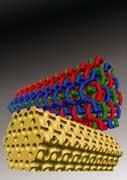Chemists in Singapore and Sweden have synthesised a porous silica material with one of the most complicated pore structures ever produced.1 The sponge-like material could have wide applications in separation science, catalysis, drug delivery, or even sensor technology.
The material created by Jackie Ying's team at the Institute of Bioengineering and Nanotechnology in Singapore, and colleagues at the Berzelii Center EXSELENT on Porous Materials, in Stockholm, Sweden, is a new type of mesoporous silica, ie porous silica with medium-sized pores in the range 2-50 nm. Mesoporous silica is technologically important because its pore size is just right for trapping small molecules while bigger molecules are filtered out. Until now, these materials have comprised only single or at best binary networks of disconnected pore systems and are used in separation science as molecular sieves and in catalysis. (Mesoporous materials are used in catalytic cracking in the petrochemical industry for making different types of fuel molecules for diesel, petrol and aviation fuel.)

All important in determining just how useful a particular mesoporous material might be are the precise size and shape of its pores. Different shapes will be responsive to different small molecules that might enter in different ways and have diverse effects on how the material interacts or changes those small molecules. The material made by Ying's group is unique because it has not two but three interwoven but disconnected pore systems. This added level of complexity gives the chemists an extra variable with which to work in creating pore sizes and shapes tailored to particular molecules and so particular types of chemical separation or catalytic processes.
To make their new porous material, known as IBN-9, Ying's team designed a new template around which they could form the novel complex structure from building block molecules. The template compound, a surfactant made from N, N-dimethyl-l-phenylalanine in two steps, has large head groups and long hydrocarbon tails ending with a nitrogen-containing amine group. One end of the template is hydrophilic, the other is hydrophobic. The template forms ordered structures around which silica crystals can grow. Once the structure is formed, the chemists dissolve away the template molecule leaving behind the hollowed out mesoporous silica.
The researchers explain that by fine-tuning the ratio of the size of the surfactant molecules to the size of the head group and the degree of hydrophobicity and hydrophilicity of the tail, they can control the final pores that form in their new materials. They suggest that the presence of both long and short channels in fibres of the material could lead to separation or controlled-release applications, for drug or agrochemical delivery, that offer different diffusion rates in different directions.
Related Links
Latest science and medical news
References
- J.Yinget al, Nature Chem., 2009, 1, 123.






No comments yet